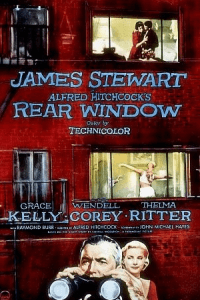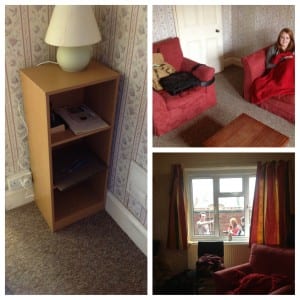Tiffany Thompson
The living room normally where the family sits and socializes. This room was once was used for special occasions, this room was the best decorated. It also was used as a resting space for dead, the late family members would be laid in their coffin in the best room of the house, the living room.
However, times have changed “The modern era has seen the focus of the room shift from the coffin to the box” ((Heathcote, Edwin (2012) Meaning of Home, London: Frances Lincoln. p.36.)), now the television is the center of the living room with all the furniture pointing to it with families staring into a void of reality TV.
Samuel Davis
With Heathcote’s quote in mind about the television as a focal point, we decided (Me, Tiffany and Lauren) to use the TV as a focal point in a performance. To start this process, we watched a series of films to gather research. Whilst doing this, we wanted to feel comfortable so we played around with the feel of the room by moving the furniture and creating a cosy feel. At the same time, we interacted with people moving in and out of the room (which frequently happened). The first film was The Moon and the Sledgehammer ((dir.Philip Trevelyan)) which followed a 1972 family who lived without running water, gas or mains electricity. The ideas that sprang from this was how the use of technology has killed any social interaction that once occurred in living rooms. Phrases now familiar in living rooms up and down the country feature ‘turn the TV up’ and ‘be quiet I can’t hear the tele’. Many ideas began circulating after the film and our first thought was too create a performance where audience members would encounter technology being used in the living room, slowly this would be taken away, until there was no electricity, TV, or anything technological.
However, we further developed our research by watching Hitchcock’s famous Rear Window film and realised that we could include as many normal activities that we do ourselves in our living rooms.
|
The 1954 film poster for Alfred Hitchcock’s Rear Window. ((Paramount (1954) “Rear Window,” Colour Poster 1954 Paramount. [image online] Available at: http://uk.imdb.com/media/rm1147639808/tt0047396?ref_=tt_ov_i [Accessed: Sunday 7th April 2013].)) |
Lauren will talk more about these activities later in this post, but it will happen live during the performance and create that notion of being in a living room. Looking back historically we learn that the living room was often ‘saved for best’ as it was used for deceased family members “The front room was preserved – like the cellophane-shrouded three-piece suite – for best” ((Heathcote, Edwin (2012) Meaning of Home, London: Frances Lincoln. p.35)) Following this, we wanted to create a juxtaposition of reserving the living room for best by playing on the natural design of the scruffy West Parade house. We will do this by changing the aesthetic of the living room by using certain objects to create an effect.
|
Photograph showing how we have moved the furniture to create a ‘homely’ feel. We also played with the idea of performing outside. Photograph and editing by Sam Davis. |
I think the use of the television will be integral to our performance. One idea was to have a loop of different TV shows playing. I thought it would be interesting to keep these TV shows on a similar theme so that they all talk about the notion of home. For example, we are in the living room at East Lodge watching an episode of Eastenders where the characters are at home watching TV whilst talking about an aspect of home. Then the TV will flick channels to Rear Window ((dir. Alfred Hitchcock)) or The Moon and The Sledge Hammer ((dir.Philip Trevelyan)) showing their family home.
Lauren Walker
In our performance we want to incorporate the feelings that you would, (in your every day life) feel when sat in your living room. We also wanted to merge the different ‘rituals’ that happen when you are sat in your living room, this could be simply turning the television over. The living room in the house has a very ‘shabby’ look to it with its ripped wallpaper and old fashioned décor which in certain aspects makes it not very ‘homely’ so we have decided as a group to play on the setting of a mistreated living room.
We have decided we would like the room to be very untidy and neglected. With the use of props and objects like empty pizza boxes and bottles of alcohol, we will be doing the usual things you would do if you were to sit on a weekend and relax in your living room such as drinking alcohol, ordering a pizza, watching films etc. The alcohol we choose to drink is important in our performance because although we are not playing characters, we do not want it to seem in any way classy or civilised. We will also be interacting with the audience and talking to them about everyday things, also offering them a drink or a slice of pizza. There is a cupboard in the living room and one of our ideas was to fill it with unwanted objects. This means if someone was to open it, things would fall out and this would show how neglected the room is. The cupboard also symbolizes how we put on a front too the people who are coming into the living room. A lot of our discussion has been about the feeling when someone is in your living room and you tend to play up to it and ‘put a front on’ we explored how that made you feel when people were sat with you in your living room and how you feel that you cant fully relax “he word ‘gemutlich’ (comfortable) described in ‘human space’ as “conduct in which man abandons the exertion of his will and of active behaviour and allows himself to relax in peace and quiet” ((Bollnow, O.F (2011) “Human Space” London: Hyphen Press p.142-143.))

